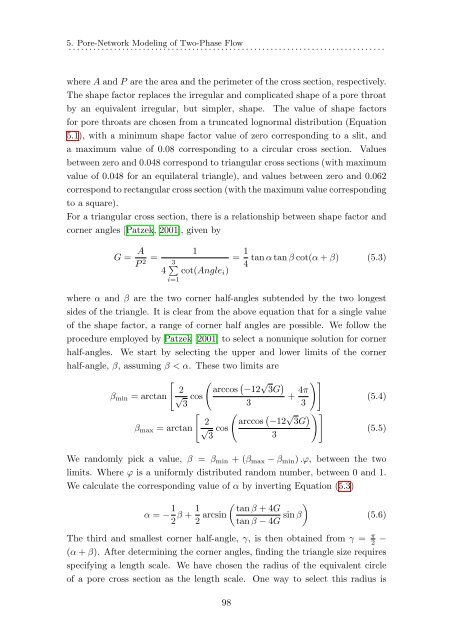download pdf version of PhD book - Universiteit Utrecht
download pdf version of PhD book - Universiteit Utrecht
download pdf version of PhD book - Universiteit Utrecht
You also want an ePaper? Increase the reach of your titles
YUMPU automatically turns print PDFs into web optimized ePapers that Google loves.
5. Pore-Network Modeling <strong>of</strong> Two-Phase Flow<br />
. . . . . . . . . . . . . . . . . . . . . . . . . . . . . . . . . . . . . . . . . . . . . . . . . . . . . . . . . . . . . . . . . . . . . . . . . . . . .<br />
where A and P are the area and the perimeter <strong>of</strong> the cross section, respectively.<br />
The shape factor replaces the irregular and complicated shape <strong>of</strong> a pore throat<br />
by an equivalent irregular, but simpler, shape. The value <strong>of</strong> shape factors<br />
for pore throats are chosen from a truncated lognormal distribution (Equation<br />
5.1), with a minimum shape factor value <strong>of</strong> zero corresponding to a slit, and<br />
a maximum value <strong>of</strong> 0.08 corresponding to a circular cross section. Values<br />
between zero and 0.048 correspond to triangular cross sections (with maximum<br />
value <strong>of</strong> 0.048 for an equilateral triangle), and values between zero and 0.062<br />
correspond to rectangular cross section (with the maximum value corresponding<br />
to a square).<br />
For a triangular cross section, there is a relationship between shape factor and<br />
corner angles [Patzek, 2001], given by<br />
G = A P 2 = 1<br />
∑<br />
4 3 cot(Angle i )<br />
i=1<br />
= 1 tan α tan β cot(α + β) (5.3)<br />
4<br />
where α and β are the two corner half-angles subtended by the two longest<br />
sides <strong>of</strong> the triangle. It is clear from the above equation that for a single value<br />
<strong>of</strong> the shape factor, a range <strong>of</strong> corner half angles are possible. We follow the<br />
procedure employed by Patzek [2001] to select a nonunique solution for corner<br />
half-angles. We start by selecting the upper and lower limits <strong>of</strong> the corner<br />
half-angle, β, assuming β < α. These two limits are<br />
[ ( ( √ ) )]<br />
2 arccos −12 3G<br />
β min = arctan √ cos<br />
+ 4π 3 3<br />
3<br />
[ ( ( √ ))]<br />
2 arccos −12 3G<br />
β max = arctan √ cos 3 3<br />
(5.4)<br />
(5.5)<br />
We randomly pick a value, β = β min + (β max − β min ) .ϕ, between the two<br />
limits. Where ϕ is a uniformly distributed random number, between 0 and 1.<br />
We calculate the corresponding value <strong>of</strong> α by inverting Equation (5.3)<br />
α = − 1 2 β + 1 2 arcsin ( tan β + 4G<br />
tan β − 4G sin β )<br />
(5.6)<br />
The third and smallest corner half-angle, γ, is then obtained from γ = π 2 −<br />
(α + β). After determining the corner angles, finding the triangle size requires<br />
specifying a length scale. We have chosen the radius <strong>of</strong> the equivalent circle<br />
<strong>of</strong> a pore cross section as the length scale. One way to select this radius is<br />
98

















